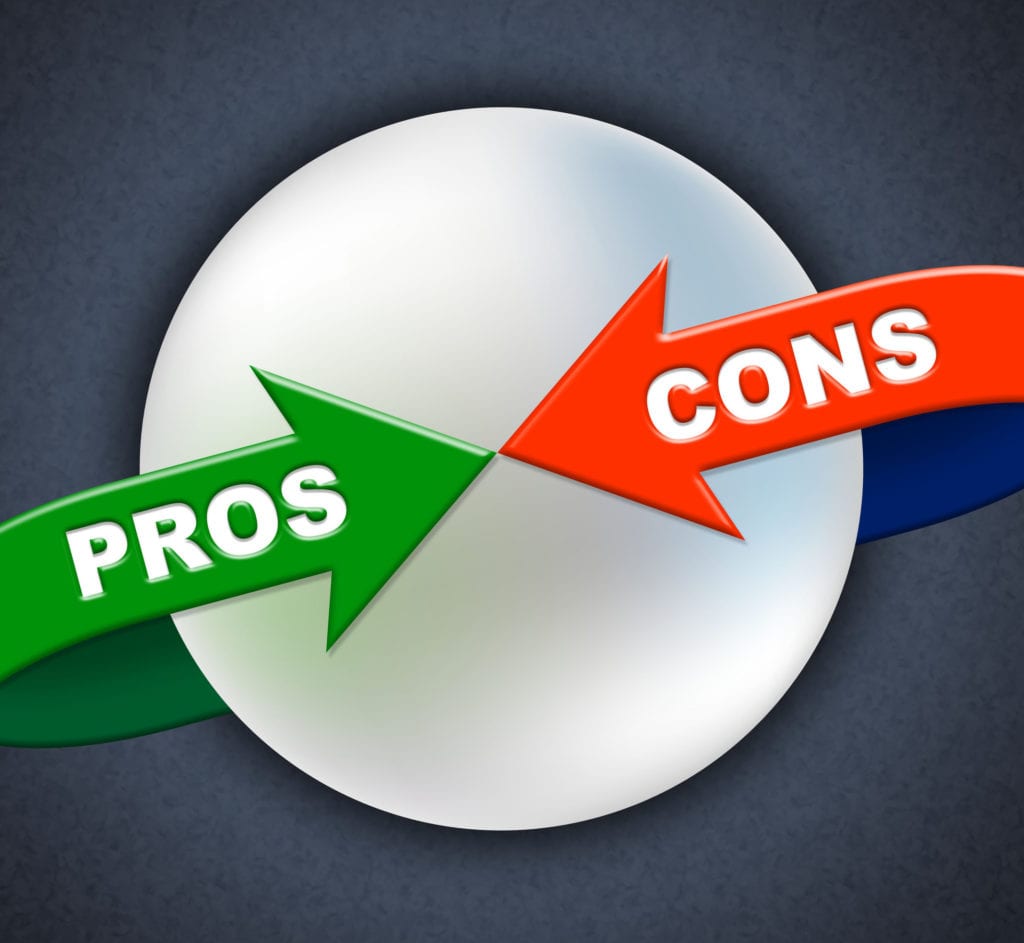

In 2021, the online learning market size exceeded USD 315 billion, and experts forecast a 20% compound annual growth rate (CAGR) between 2022 and 2028. This research from Global Market Insights indicates a significant surge in demand for online courses.
Clearly, having a reliable and user-friendly learning management system (LMS) is crucial for educators and entrepreneurs alike.
One LMS that has been making waves in the industry is LearnDash.
It boasts an impressive list of features and integrations, making it a top choice for many course creators. But is LearnDash the right fit for you? Let’s dig deeper into its course builder, key features, and the pros and cons to help you make an informed decision.
LearnDash Overview
LearnDash is an LMS plugin for WordPress that allows you to create and manage courses, quizzes and assessments, gamification, progress tracking and reporting, and third-party integrations.
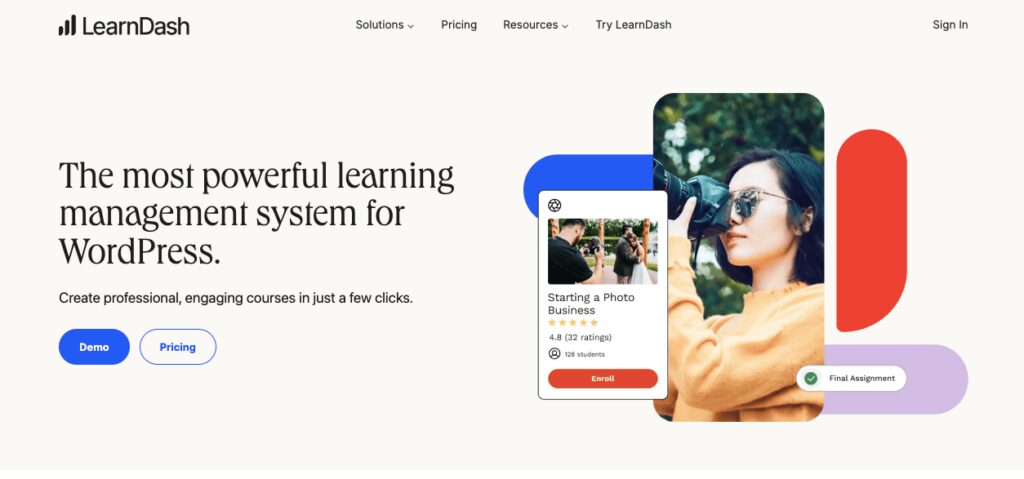

It caters to various audiences – from small-scale online course creators to large universities and corporations.
Here’s a quick overview of LearnDash’s key features:
- Drag & drop course builder to make the course creation simple.
- Dynamic content delivery with drip-feed lessons, prerequisites, and learning paths.
- Flexible pricing models with one-time purchases, subscriptions, memberships, and course bundles.
- Payment gateways with built-in Stripe integration or WooCommerce compatibility.
- Badges & certificates to reward learners based on their performance and completion.
- Automated notifications to provide instant feedback and communication to your audience.
- Profile dashboard to let learners view their courses, quiz scores, and points earned.
- Integrations with popular business apps and plugins.
The best part is the user-friendly interface that lets you create multimedia-rich courses.
And LearnDash not only helps you create engaging courses, but you can also deliver and monetize them using the same interface.
This means you can focus on creating the best possible courses without having to worry about the technical details of course delivery and monetization.
LearnDash Key Features
1. Course creation and management
LearnDash has a drag & drop course builder that allows you to easily add, edit, and organize your course content. It also lets you create lessons, topics, quizzes, assignments, certificates, and more with just a few clicks.
As you begin the process, you’ll get the option to pick from four types of courses, including:
- A simple course: A video or text-based course without certificates or quizzes
- Certificate courses: Courses with certificates and quizzes
- Timed courses
- Group courses: Courses led by group leaders
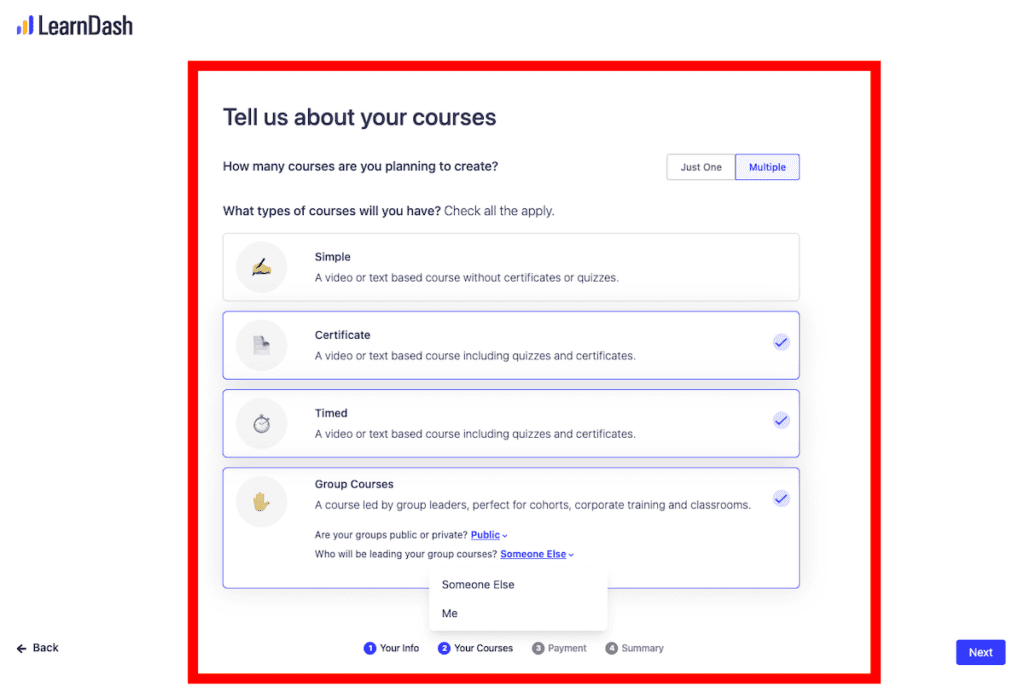

You can also choose to create multiple courses or just one.
Next, LearnDash will ask whether you want to charge for your course.
If you hit the “Yes” button, you’ll be prompted to pick from two payment methods:
You can use Stripe to charge credit cards (with low merchant fees).
Or you can pick WooCommerce if you want an all-in-one solution to manage your payments and invoices as well.
Next, they’ll automatically create the pages for your students to register for your courses, confirm successful registrations, reset their account passwords, and view their progress.
They’ll also create course listings, enable your group settings, and install some add-ons. And, of course, you can always change the settings whenever you want.
Finally, you can access your courses from the dashboard.
Now you can finally start adding course content, including lessons, topics, and quizzes.
Here’s how your course builder will appear:
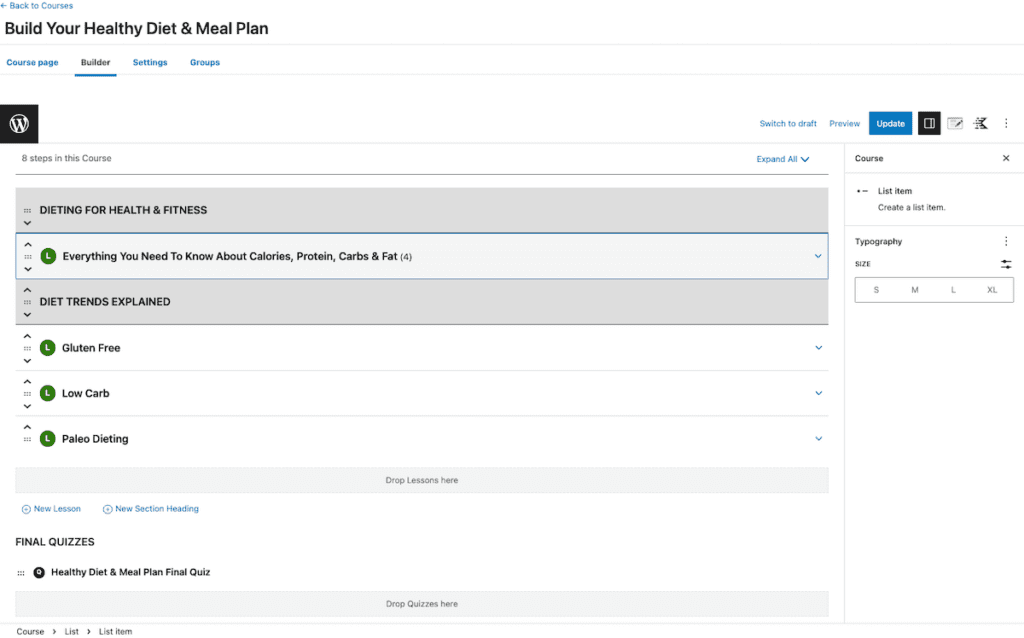

Once inside the builder, you can add videos, text files, and images for your lessons. You can also drag & drop quizzes, assignments, and many more interactive elements to enhance the overall learning experience.
You can also upload media files from the same section to the course content area and add them to lessons and topics.
Aside from creating engaging quizzes and adding media and video, you can pick and drag & drop nearly a hundred other elements to enhance your course’s appearance and usability.
Here are some of them:
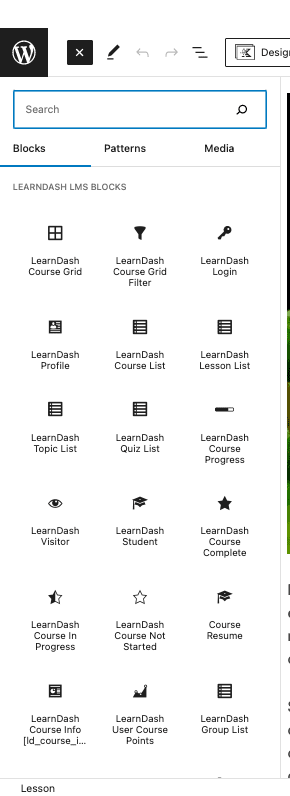

As you scroll down the elements, you’ll also see Kadence blocks to help you build custom blocks to create visually appealing course content. Further, you’ll see design elements, widgets, theme-based options, embed options, and more.
Once you’re done with the course builder, LearnDash then allows you to customize your course settings, including course access, pricing, and visibility.
For example, your course’s access options can be:
- Open: Anyone can access its content without logging in or enrolling.
- Free: The course is protected. Users need to register and enroll to access the content.
- Buy now: The course is protected via the LearnDash built-in PayPal and/or Stripe. Users need to purchase the course (one-time fee) to gain access.
- Recurring: Users need to pay a recurring fee to gain access.
- Closed: Users can only access the course through admin enrollment (manual), group enrollment, or integration (shopping cart or membership) enrollment. No enrollment button will be displayed unless a URL is set (optional).
Next, you can set up course prerequisites. This feature allows you to configure your settings in a way that requires users to complete selected courses before they are able to access the current course. You can also allow access after specific course points or set a custom access expiration period.
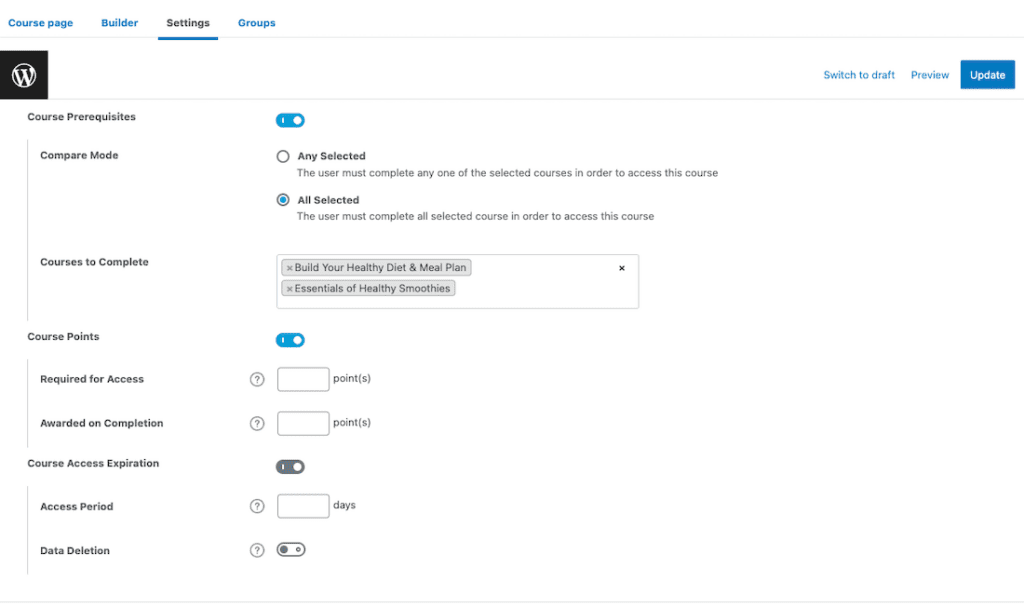

Further, you can control display options, how users interact with the content, and their navigational experience.
It’s also worth noting that the course builder is built into the WordPress environment. If you’re familiar with WordPress, you’ll find it easy to use.
However, if you’re unfamiliar with WordPress, the course builder interface may not seem intuitive. WordPress is a content management system with multiple options, menus, and settings, with a bit of a learning curve.
2. Course monetization options
LearnDash offers a wide variety of monetization options for your courses, including:
- Subscription plan: Users can enroll for a subscription plan that allows them to access all courses within a certain period of time for a fixed price per month or year. This option allows you to generate recurring income from your courses without additional work once set up.
- One-off payment plan: If users want to commit for only part of the term, they can also buy access to your course with one-off payment options like PayPal or Stripe payments.
- Membership: You can offer your course as part of a membership package. This allows learners to access multiple courses or other content for a recurring fee.
- Shopping cart integration: LearnDash integrates with popular shopping cart solutions, including WooCommerce and Samcart. This allows you to sell your courses alongside other products and services.
LearnDash also has a built-in affiliate program, allowing course creators to recruit affiliates to promote their courses. You can also set a commission rate for each sale and track affiliate performance.
You can also sell your courses individually or bundled together (e.g., a bundle of three courses).
3. Quizzes and assessments
Quizzes and assessments are vital to any e-learning platform, and LearnDash offers built-in tools to create and manage them.
You’ll find a “Quizzes” section on the left nav bar of your LearnDash dashboard, where you can add, edit, manage, and move around your quizzes. You’ll also be able to change the appearance of the quiz, configure settings, and choose question types.
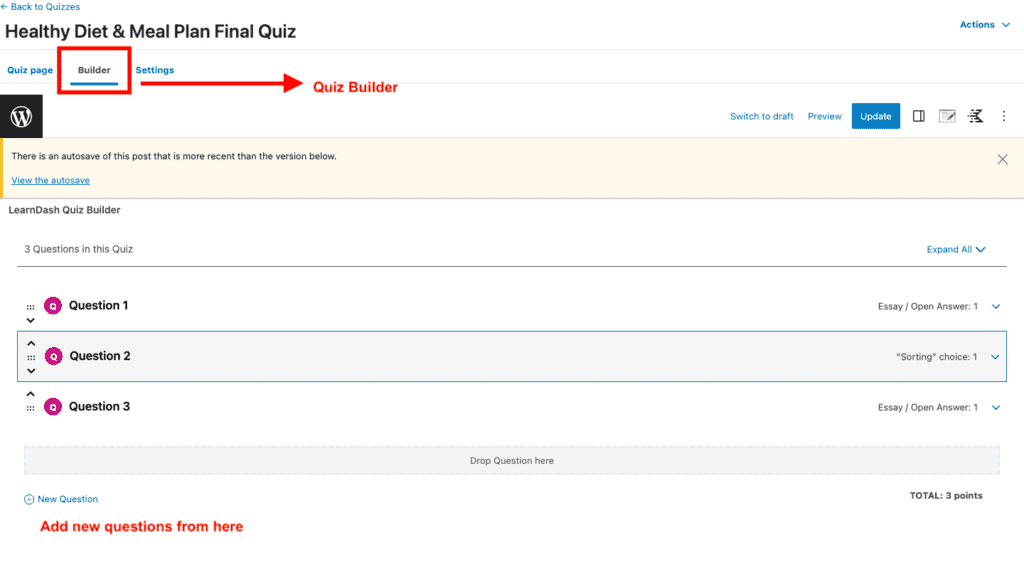

You can also pick your question type as you start adding or editing questions.
With LearnDash quizzes, you can create quizzes with eight different question types, including:
- Single choice
- Multiple choice
- Free choice
- Sorting choice
- Matrix sorting choice
- Fill-in-the-blank
- Assessment
- Essay
Quiz builder’s interface makes it super easy to add, edit, move, and delete questions.
Once you’re done playing around with the quiz builder, it’s time to configure the settings to customize how your quizzes look and behave. You can access them by navigating to LEARNDASH LMS > QUIZZES and clicking on the Settings tab of the quiz you want to edit.
From here, you can configure the Quiz access settings and the release schedule. For instance, do you want your quiz to be available on course enrollment or X days after course enrollment? Or do you want to display it on a specific date?
You can also select one or more quizzes that must be completed before taking this quiz or restrict the access to only registered users.
There are more options to further control the requirement for accessing and completing the quiz, including passing score, quiz retakes, number of retries allowed, and time limit.
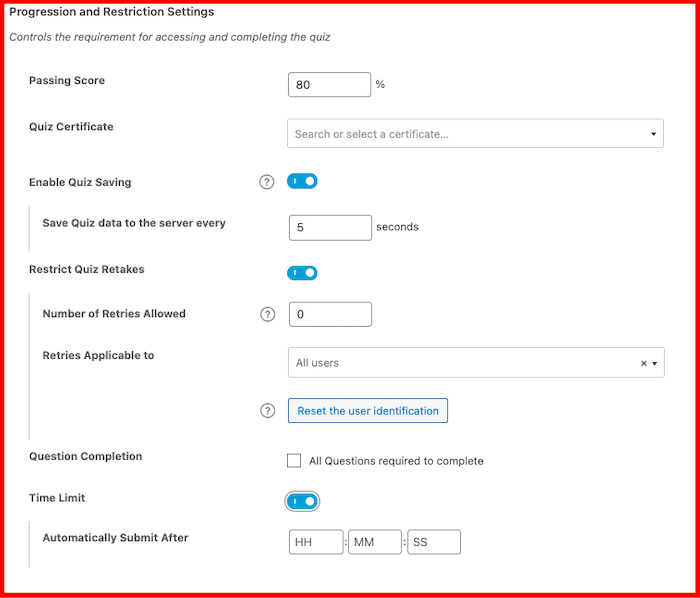

Next, you can control how the quiz will appear to the audience and what will be displayed. This includes settings like randomizing the quiz order, skip question option, etcetera.
Other quiz & assessment features include:
- Quiz statistics: You can enable quiz statistics to track and analyze the performance of your learners on your quizzes. You’ll be able to see details like number of attempts, average score, time spent, etc. You can also export the statistics data as CSV files.
- Quiz email notifications: You can set up custom email notifications for quiz results sent to learners and administrators.
- Quiz leaderboard: You can enable a leaderboard for your quiz that shows the top performers based on their score and time. You can also set a custom time format for the leaderboard.
4. Student engagement options
There are several ways LearnDash can help you improve student engagement.
To begin, you can embed videos, audio, images, and PDFs, into your courses and quizzes. This provides a more engaging and diverse learning experience for learners.
You can also award badges and certificates to your students for completing courses, lessons, quizzes, and assignments. This provides a sense of achievement and encourages them to continue their progress.
On top of that, you can group certain users and assign a group leader to track the progress and performance of any user in their group. You can associate any number of courses with these groups, and anyone in that group will be automatically enrolled in the course.
And just like courses, you’ll also get options to monetize your groups.


You can use groups to sell access to multiple courses for a single price. Or, create course bundles that offer access to multiple groups for a discounted price. This can attract more customers and increase your revenue.
Here are some more built-in student engagement features that LearnDash offers:
- Focus mode: LearnDash’s focus mode eliminates distractions by hiding unnecessary elements on the course page.
- Video progression: Allows you to mandate your students to watch a complete video before proceeding to the subsequent lesson or quiz.
- Automated notifications: Send email notifications to your students based on certain triggers, including completing a lesson, passing a quiz, earning a badge, etc.
- Content drip-feeding: Gradually release course content over time, keeping your students interested and engaged.
- Discussion forums: Foster a sense of community and encourage learners to stay engaged with the course.
5. Progress tracking and reporting
LearnDash does provide some basic reporting features, but they may not be enough for some users who need more advanced and detailed reports.
Just head to “Reports” from the left nav bar and “Export User Course Data.”
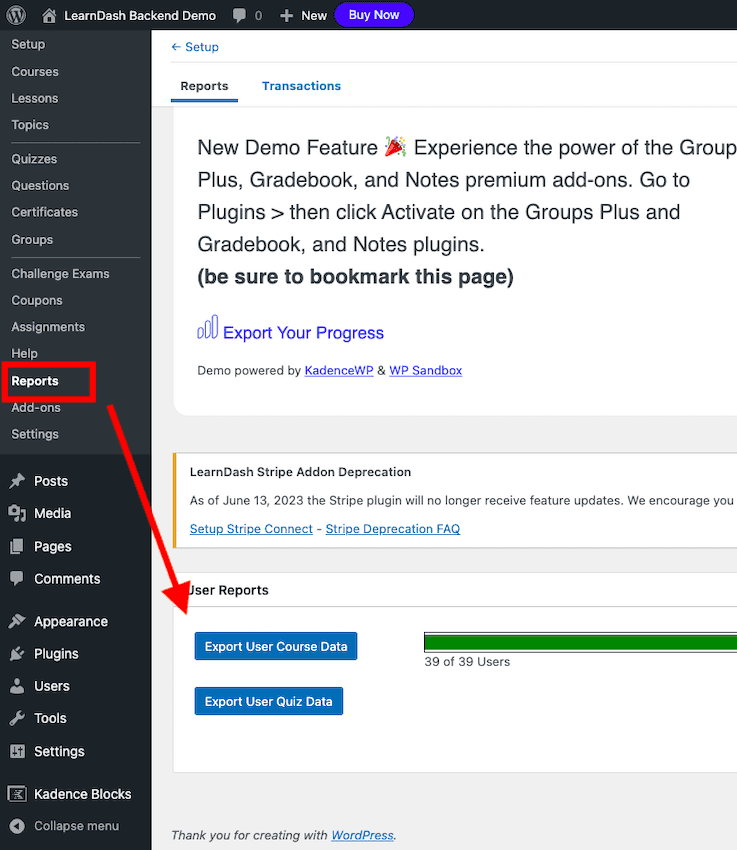

For more detailed reports, you’ll have to use additional tools like ProPanel or SCORM and xAPI1 to get more metrics and insights.
6. Integrations with third-party tools
LearnDash offers a wide range of integrations with over 30 third-party tools, which can help you improve your online courses’ functionality and overall user experience. While some of these integrations are available for free, others may require a fee.
These integrations cover a broad spectrum of features, including eCommerce, membership, marketing tools, and various communication platforms.
For example, you can integrate LearnDash with WooCommerce, a popular eCommerce platform, to manage your course payments, subscriptions, and other related activities.
It also provides native integration with popular membership plugins like MemberPress or Paid Memberships Pro to create custom membership levels for your courses and control access to your content.
Additionally, LearnDash also integrates with popular email marketing services like Mailchimp and ConvertKit, allowing you to automate email campaigns and send targeted messages to your students based on their behavior and performance.
Other popular integrations include:
- Zapier: A tool that lets you connect LearnDash with thousands of other apps, such as Gmail, Slack, Mailchimp, etc., and automate your workflows.
- BuddyPress: A social networking plugin that adds LearnDash activity streams, private messaging, and custom profiles for your learners.
- H5P: H5P is a free and open-source tool that lets you create interactive content, such as quizzes, presentations, and games. With the LearnDash-H5P integration, you can embed H5P content into your LearnDash courses and enhance their interactivity and engagement.
7. Customer support options
Customer support is an important aspect of any online learning platform. LearnDash offers various options for customers to get help and resolve their issues. Some of the customer support options are:
LearnDash Help Center: The LearnDash Help Center contains comprehensive articles on everything from setting up your site to adding courses on the fly. You can also search for answers to specific questions using the search bar at the top of every page. The help page also has a contact form for pre-sales questions and a link to the support site for license holders.
Knowledge Base: LearnDash has a separate knowledge base where customers can access user guides, troubleshooting tips, and code references.
Live chat: LearnDash offers live chat with their experts during specific times throughout the week and the day. Customers can use the live chat feature to ask questions, get feedback, and solve problems in real time.
Community forums: LearnDash has a vibrant Facebook community of users who share their experiences, insights, and best practices on various forums and groups. Customers can join this forum, get help from other LearnDash users, and learn from their success stories and challenges.
User Interface and User Experience
Ease of use for administrators
LearnDash is designed to create and sell online courses on WordPress. One feature that sets LearnDash apart is its user-friendly interface for administrators.
However, since it runs only on WordPress, you need to know how WordPress works and how to set up your site, hosting, domain, and security.
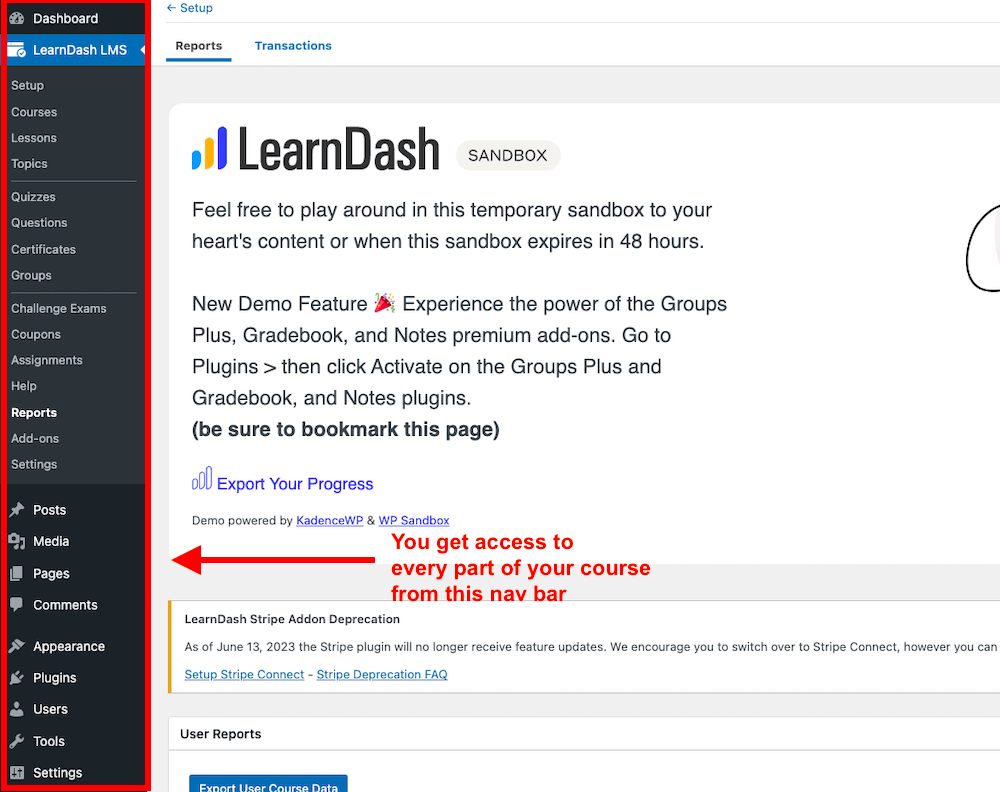

One aspect that contributes to the ease of use for administrators is the flexible course creation feature. With LearnDash, you can create courses with different pricing models, content types, access levels, and design options.
And that’s not it.
If you opt for LearnDash’s cloud-based version (which costs $24/month if paid annually), you’ll be able to create and host your online courses without having to build and maintain a separate WordPress site.
This can save you a lot of time, money, and hassle, as you don’t have to worry about themes, hosting, plugins, updates, security, or backups. You can focus on creating and selling your courses, while LearnDash takes care of the technical aspects.
You can also customize your course site’s layout and appearance with any WordPress theme or page builder or use templates provided by LearnDash or third-party providers.
You’ll see templates for different industries as well, including training courses, fitness, SEO, and many more.
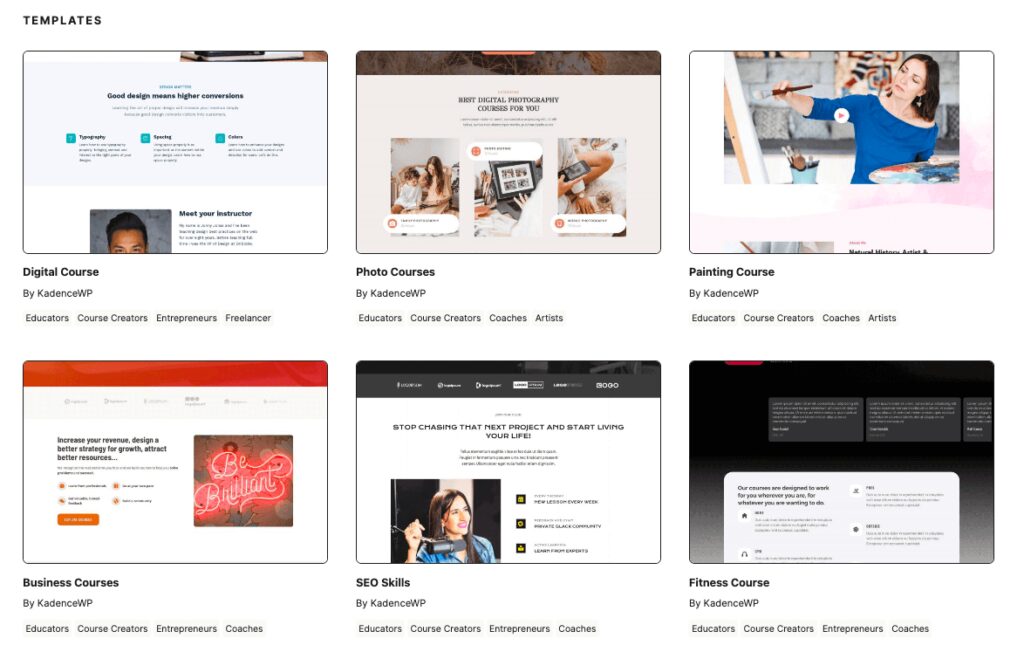

Additionally, built-in tools and integrations like certificates, quizzes, assignments, badges, points, and leaderboards help enhance learning outcomes and engagement. You can also integrate LearnDash with popular plugins and services like WooCommerce, Stripe, PayPal, Zapier, and Mailchimp.
Moreover, LearnDash offers chat support and a wealth of resources like documentation, tutorials, videos, blog posts, and forums to assist you in using the platform.
You can also request a demo or try LearnDash to experience its user-friendly interface and other features.
Ease of use for learners
LearnDash not only provides a user-friendly interface and experience for course creators but also for learners.
Learners will see a clear and logical structure for courses, with well-organized topics, lessons, and quizzes. They can also see their progress and track completion status at a glance.
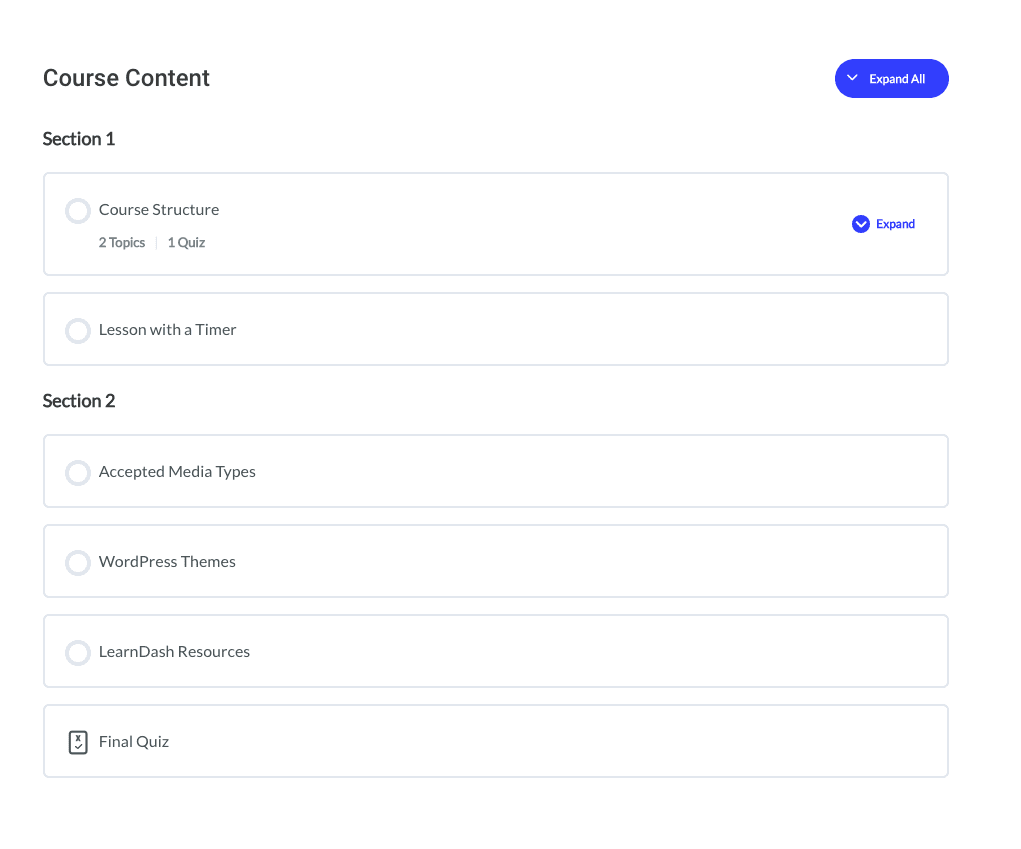

Responsive design is another bonus. LearnDash courses come optimized for different devices and screen sizes, including desktops, laptops, tablets, and smartphones. Learners can access their courses from anywhere, anytime, and continue learning at their own pace.
In addition, LearnDash’s social learning features, like discussion forums and group assignments, allow learners to collaborate and share with their fellow students.
Design and customization options
LearnDash lets you create courses with different content types, design options, and layout styles.
One of the ways LearnDash allows you to customize your courses is through its compatibility with any WordPress theme. This means you can use any theme you like and still be able to create and manage courses using LearnDash.
LearnDash also provides pre-built templates as a starting point for your courses. These templates can save you time and effort, so you don’t have to design your course from scratch.
Another way LearnDash enables you to customize your courses is through its flexible course builder. The course builder allows you to add various content types, including videos, images, audio, text, and quizzes. LearnDash also lets you add custom branding to your courses, like logos, colors, and fonts.
You can also arrange the content in any order and control the learners’ access to it through drip-feed scheduling or prerequisites.
In addition to the above, LearnDash provides several design options you can use to enhance your courses’ appearance and functionality.
For example, you can use the course grid or list layout to display your courses in an attractive and organized manner.
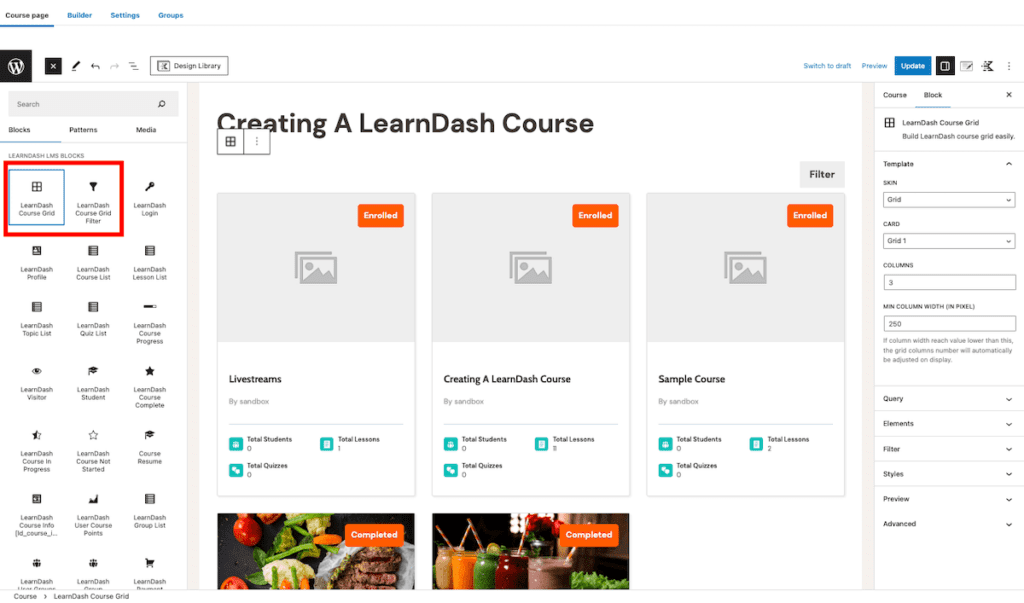

You can also use various course widgets to display course information, progress, and navigation on your site’s sidebar or footer. LearnDash also offers several course navigation options, including progress bars, breadcrumbs, and buttons that help learners move through the course easily.
Pricing and Plans
LearnDash has two pricing plans:
LearnDash LMS:
This is a WordPress plugin that you can install on your own site. It gives you complete control over your courses and site functionality. You can choose from three license options:
- 1 site license for $199 per year
- 10 site licenses for $399 per year or;
- Unlimited site licenses for $799 per year
This plan doesn’t include ProPanel, a reporting and management add-on. However, you can add ProPanel for $49 annually to get insight into your courses and learners.
LearnDash Cloud:
LearnDash Cloud is like the LearnDash plugin’s big sibling, offering everything that the LearnDash plugin does but with additional benefits. It operates like other full-fledged online course platforms, not just a plugin.
For LearnDash Cloud, you can choose from two payment options: $24 per month when paid annually or $29 per month when paid monthly.
This hosted solution includes everything you need to get started with LearnDash. It gives you a full, ready-to-go website complete with templates and customization tools to build courses that match your brand. It also includes ProPanel and iThemes Security Pro at no additional charge.
In addition, using LearnDash Cloud also allows you to promote and use your courses outside of the WordPress space. While you’ll still host your courses on WordPress, the cloud option opens up more possibilities for promotion and use beyond just WordPress plugins.
To learn more about LearnDash Cloud, read our review where we delve into the features, benefits, and quirks that shape this hosted WordPress solution.
Here’s a quick comparison overview for both these plans:
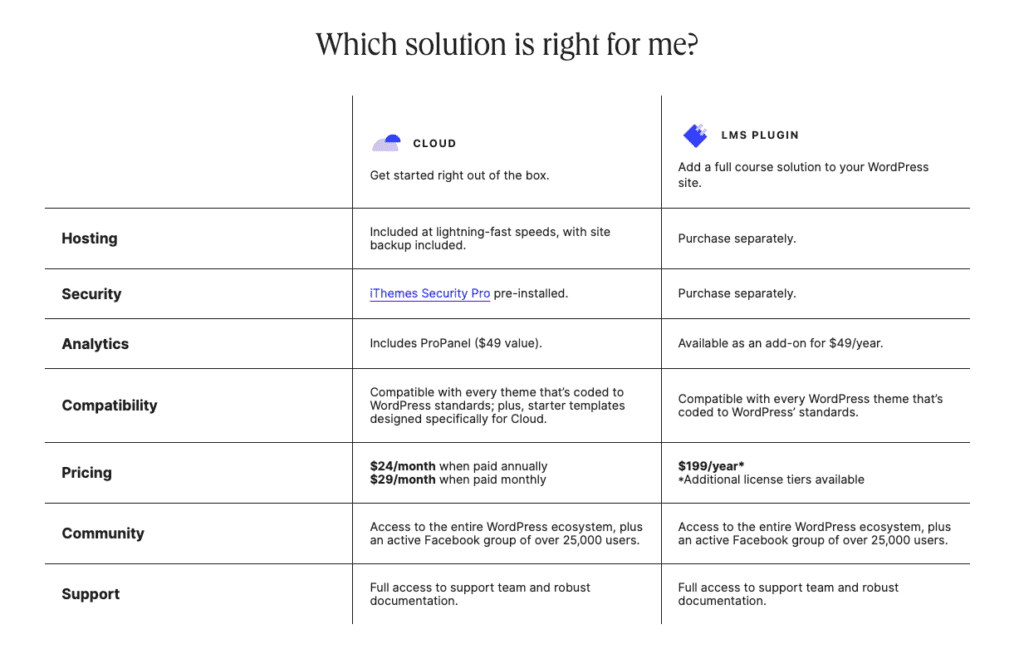

Additionally, you can install some paid add-ons to enhance your courses and site functionality.
- Groups Plus ($49 per year for one site license): An advanced group management and reporting toolkit that allows you to sell seats, track time spent in courses, assign multiple instructors, and more.
- Gradebook ($49 per year for one site license): You can customize, track, and share scores with Gradebook. It also helps you explore student progression and scores using simple tables and generate report cards.
- Notes ($49 per year for one site license): Learners can take notes as they go through your course. Notes are available for exporting and can be used for instructor communication.
LearnDash also offers a 15-day money-back guarantee if you’re unsatisfied with the product. You can also request a demo or try it for yourself for free before purchasing.
LearnDash Pros and Cons
Like any product, LearnDash has its fair share of advantages and disadvantages. Here are some of the pros and cons of using LearnDash:
Advantages of using LearnDash
- Simple UI: LearnDash has an intuitive user interface that makes creating and managing courses easy. The drag-and-drop course builder can add lessons, topics, quizzes, assignments, and more. You can also customize your course layout and appearance using any WordPress theme or page builder.
- Gamification: LearnDash allows you to gamify your courses with certificates, badges, leaderboards, and more. You can also use the achievements add-on to award badges and points for completing various activities.
- SCORM Compliant: LearnDash supports SCORM (Sharable Content Object Reference Model) – a common standard for e-learning content. Using the Tin Canny Reporting add-on, you can import or export SCORM files to or from LearnDash. SCORM helps ensure the compatibility and interoperability of your courses.
- Tons of add-ons to extend the functionality: LearnDash offers a variety of add-ons (both free and paid) to help enhance your courses’ features. You can use add-ons for design, communication, analytics, security, ecommerce, membership, forms, events, forums, and more.
You can also integrate LearnDash with popular plugins and services such as WooCommerce, Stripe, PayPal, Zapier, Mailchimp, and more.
Disadvantages of using LearnDash
- Limited built-in payment options and membership features: LearnDash only supports PayPal and Stripe as default payment gateways and does not have a native membership system. You’ll need additional plugins or integrations to offer more payment options.
- Costlier than some alternatives: LearnDash is not the cheapest option for creating online courses. It costs $199 – $799 per year, depending on the number of site licenses you need. You may also need to pay extra for some add-ons or integrations not included in the core plugin.
- No lifetime license – you need to keep renewing: LearnDash does not offer a lifetime license option. You need to renew your license every year to receive updates and support.
- Requires tech-savviness: The LMS runs only on WordPress, so you need to know how WordPress works and how to set up your site, hosting, domain, and security.
Closing Thoughts on LearnDash
In summary, LearnDash is a powerful learning management system for WordPress that offers a wide range of features and customization options for creating and selling online courses.
Its user-friendly interface, built-in tools and integrations, and expert support make it suitable for both course creators and learners. It’s also great for WordPress users who want to integrate a flexible LMS into their site.
However, it may not be the most affordable or beginner-friendly option for some users, particularly those without prior experience using WordPress. Plus, it requires some technical knowledge and effort to set up and customize.
If you are looking for an LMS that offers a robust and customizable platform with expert support and a vast range of integrations, LearnDash is definitely worth considering. However, if you are on a tight budget or have limited technical skills, you may want to explore other alternatives.
Although LearnDash is a great option for building online courses, it’s a great idea to compare different LMS platforms before making a final decision. For instance, check out our analysis of LearnDash vs. LifterLMS, where we compare the features and pricing of both platforms to help you make an informed choice.
In conclusion, LearnDash comes with a suite of tools to create and manage online courses, offering a blend of features and customization options. Take your time to evaluate your specific needs and compare LearnDash with other LMS platforms to ensure you find the perfect fit for your online course journey.
LearnDash Video Script:
LearnDash is a WordPress plugin that lets you create and sell online courses on your own website. It gives you complete control over your courses and site functionality and helps you create courses with different content types, design options, and layout styles.
But what makes LearnDash stand out from other LMS plugins or platforms?
Firstly, LearnDash lets you create and sell courses with different pricing models, content types, access levels, and design options. You can also use templates to get started quickly or use any WordPress theme or page builder to customize your course layout and appearance.
Secondly, with LearnDash, you can bring out the competitive spirit in your learners. Using quizzes, assignments, badges, and leaderboards, you can make learning engaging and fun.
If the built-in features don’t cut it for you, you can always integrate it with popular plugins and services like WooCommerce, Stripe, PayPal, Zapier, Mailchimp, and more.
Next, you have the group management feature. Do you have a group of learners that need to stay on track together? LearnDash has got you covered! You can group certain users together and assign a group leader to track their progress and performance.
And last but not least, LearnDash offers expert support and resources whenever you need assistance. You can access documentation, tutorials, videos, blog posts, forums, and more to learn more about LearnDash and how to use it effectively. It’s like having your own personal learning coach!
So, there you have it! With LearnDash, you can create, manage, and sell online courses like a pro. Don’t just take my word for it, give it a try and see for yourself!
Table of Contents



